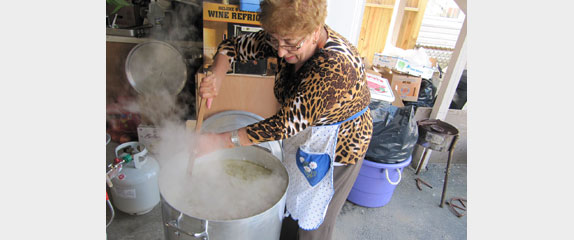Preparation is half the fun for Feast of San Giuseppe
By Debra Samuels, Globe Correspondent March 31, 2010
GLOUCESTER — In the garage-cum-kitchen of Nina and Franco Groppo’s home here, more than 20 friends and extended family are preparing for the Feast of San Giuseppe. That means pasta making — lots of it — along with plenty of fun. Flour sifting through the air around him, Pasquale Vitale throws his head back and calls out: “Comu semu tutti muti?’’ (Let me hear your voices.) The pasta makers respond: “Viva San Giuseppe Viva!’’
This Sicilian cheer, honoring St. Joseph, the patron saint of families, is repeated many times for several days in this makeshift work space. The feast, a gesture of gratitude for the bounty of life, is held a week later on March 19. Many people who hail from the tiny village of Trappeto, hometown of the Groppos, attend, but you don’t have to be Italian to participate. Neighbors Marilyn Swift, Catherine Gunn, and Bev Gardner have been helping for years. “Bring a friend. Tell them to bring a friend. Everyone is welcome,’’ says Nina Groppo. “See how many people St. Joseph brings into my life?’’ She is the heart of this celebration.
The Groppos have been doing this for 14 years. In the house, a three-tiered altar with a statue of St. Joseph at the top adorns their den. Flowers and religious figurines, framed by swags of mauve-colored satin and lace, attend the saint.
The garage kitchen is filled with tables, where pasta makers will eventually roll out 100 pounds of dough and turn it into thick strands of a fettuccine-like tagliarini. Grace Sciortino assists son Sal, 13, as he feeds dough though a pasta machine. “More flour,’’ instructs Nina Groppo. Her husband and Vitale set the cut pasta to dry on door-size plywood planks. As one board fills, they set another on wooden blocks. Within an hour, they stack six boards like an urban parking lot. The pasta will dry all week.
Ninfa Briguglio tends a pot of milk simmering on the stove. “I’m making ricotta,’’ she says. “It couldn’t be easier: Heat milk, cream, salt, and vinegar — you get ricotta.’’ Forty minutes later she scoops the creamy warm curds and whey into plastic bowls to reward everyone for the day’s work.
The next week, on the eve of the feast, folks gather again to prepare focaccia sandwiches with fillings that include cheese, anchovies, tomatoes, salted Alaskan salmon, and basil. The workers pare artichokes for fritters and fill more than 100 bags with bread, an orange, and a lemon. The orange promises sweetness, the lemon recalls the bitterness of the past, and the bread represents nourishment. They also make conza, the traditional sauce/soup of beans, cauliflower, and fennel. Conza will be tossed with all that pasta made the week before. Four pounds each of chickpeas, lentils, white and red beans, black-eyed peas, and favas are cooked separately before being mixed together Friday morning. That same day, the workers cut cauliflower into florets along with fragrant wild fennel, sent from Franco Groppo’s cousin in California. As they chop, the intense aroma of anise deepens.
At dusk on the eve of the feast, votive candles are twinkling as dozens arrive at the Groppos’ for a Mass led by Father Antonio Nardoianni of St. Leonard’s Parish in the North End. Several breads in the shape of animals and Christian symbols are on the altar. They were made by Dominic D’Amico and his daughter, Maria Cracchiolo of Caffe Sicilia in Gloucester. After the service and a light supper of focaccia sandwiches, Groppo’s home cured olives, fresh fruit, and pastry, everyone leaves with a bag of bread and fruit.
On feast day, more than 100 celebrants glide through the Groppos’ home. The conza simmers from early morning in an 80-quart pot. In the backyard, Joseph Briguglio stands over a huge vat of bubbling oil and deep-fried artichoke fritters. He reminds everyone this is his feast day: “No one can be mean to me today!’’ His wife, Ninfa, dips the chokes in a yeasty batter, depositing them into the oil one by one. Once they are fried, he sets them down and everyone nearby grabs one. Enzo Barna is making panelle, deep-fried chickpea squares. In the kitchen, tables are groaning with huge aluminum pans of sweet and sour fish, baked stuffed jumbo shrimp, the eggplant relish caponata, orange and fennel salad, marinated octopus salad, and Italian cookies and desserts wrapped in cellophane.
Everyone is waiting for the homemade pasta di San Giuseppe. The water comes to a boil and Salvatore Cracchiolo and Franco Groppo tip in the pasta. When it’s ready, the men begin what looks like a ballet. They fill two giant bowls first with sauce, then pasta, then sauce, then pasta. Carlo Randazzo tosses it together. Vitale’s daughter, Angela, helps serve the crowd, many of whom return for a refill.
Then a shout: “Comu semu tutti muti?’’
And the response: “Viva San Giuseppe Viva!’’











 Debra Samuels, bestselling author, food writer and cooking instructor,
Debra Samuels, bestselling author, food writer and cooking instructor, 


